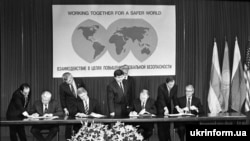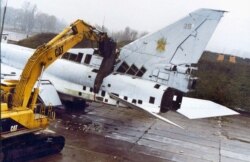On December 18, the Russian news agency Interfax published an article in which Sergei Ryabkov, the deputy foreign minister, falsely claimed Russia had fulfilled its obligations under the 1994 Budapest Memorandum on Security Assurances.
This is the agreement by which Ukraine, Belarus and Kazakhstan gave up their leftover Soviet nuclear arsenals in exchange for protecting their 1991 borders.
“The Budapest Memorandum concerns security guarantees for Ukraine as a non-nuclear state within the meaning of the NPT (Non-Proliferation Treaty),” he said. “And from this point of view, all guarantees have been provided and observed.”
Ryabkov went on with this obfuscating mashup:
“But in the Budapest Memorandum there is not a word about coups d'etat in Ukraine and subsequent actions, nor about the possibility [of] calling things by their proper names, about a part of the population who at that time lived within Ukraine, making conclusions about whether it is worth continuing to live there or it is necessary to return to the Russian Federation.”
To be clear: With its occupation of Ukrainian territory in Crimea and by nurturing a separatist war in Donbas, Russia has violated the most basic tenets of the Budapest memo.
In fact, the first point of the memorandum is the following:
“The United States of America, the Russian Federation, and the United Kingdom of Great Britain and Northern Ireland, reaffirm their commitment to Ukraine … to respect the Independence and Sovereignty and the existing borders of Ukraine.”
Clearly, Russia has violated this point.
Ryabkov’s talk of “coups d’etat” in Ukraine is a reference to the false Russian claim that Ukraine’s 2014 “Maidan Revolution” was a coup orchestrated by the West.
The argument echoes rhetoric used by Russian President Vladimir Putin and Russian officials since the Kremlin's forced annexation of Crimea. In this misleading narrative, the change in government after then-President Viktor Yanukovych fled the country in 2014 supposedly nullified the “Ukraine” with which Russia had signed the Budapest memo and other treaties.
This is sheer sophistry, since nothing in the memo suggests that a change in government somehow voids the agreement. Moreover, Russia continues to officially recognize the post-Maidan government of Ukraine.
Ryabkov’s further claim about a “part of the population” in Ukraine deciding to “return to the Russian Federation” refers to the Russian fiction that the Crimean annexation was an expression of the will of the Crimean population.
In reality, the “referendum” of the people was initiated by Russian military intervention, starting with the seizure of the Crimean parliament on February 27, with the voting taking place little over two weeks later under de facto conditions of a Russian occupation. The voting was not monitored by independent observers.
Point two of the Budapest memo reads:
“The United States of America, the Russian Federation, and the United Kingdom of Great Britain and Northern Ireland, reaffirm their obligation to refrain from the threat or use of force against the territorial integrity or political independence of Ukraine, and that none of their weapons will ever be used against Ukraine except in self-defense or otherwise in accordance with the Charter of the United Nations.”
Once again, it is obvious that Russia’s actions in Crimea and in Donbas violate the use-of-force agreement. In fact, with some 100,000 troops currently deployed around Ukraine’s borders, Russia is again violating this point by deploying what Ukraine and the European Union consider threatening force.
Since November, Russia has been positioning these military forces while making demands from NATO for “security assurances.” Although Russian officials have repeatedly denied any aggressive intent, there are no large-scale, scheduled military exercises to explain the buildup.
Observers note the installation of logistical stockpiles, medical facilities and command-and-control structures to support military operations.
In Ukraine’s eastern Donbas region, Russian forces and their collaborators continue to wage war against the government. Since the fighting broke out in 2014, there have been more than 14,000 civilian and military deaths, according to Russia's count. Despite overt ties to the pseudo-states established in Donbas, (the “Donetsk People’s Republic” and “Luhansk People’s Republic,”) Russia still officially recognizes these territories as part of Ukraine.
Russia seized the Crimean Peninsula following the February 2014 Maidan revolution, also known as the “Revolution of Dignity.” Yanukovych fled the country while facing consequences for the use of live rounds against protesters, among other allegations.






